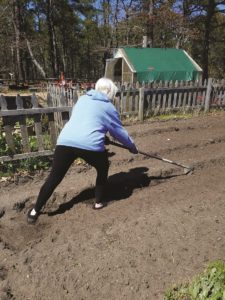Gardening is good for the soul. But if you don’t pay attention to good body mechanics, it can be hard on your back — or your knees, wrists, and elbows.
Just being outdoors and connecting with nature relieves stress. And gardening is actually good exercise — think of all the squatting, lifting, and reaching involved — as long as you choose the right tools, use your body the right way, and pace yourself.

Here are my six rules for ensuring your time in the garden will increase your strength and flexibility instead of adding to your aches and pains:
- Warm up first. Prepare your body before you get your hands in the dirt. Here are some gentle stretches to limber up your back, arms, and legs, so that you can move more freely when you get down to business. For each of these (except the wrist circles), move until you feel a bit of tightness or pulling, then hold for 20 seconds, and repeat three times.
- Double knee to chest. Start on your back, pull your knees to your chest, and hold them there with your hands on the back of your thighs.
- Resting twist. Still on your back with your knees bent, allow your knees to fall to one side to create rotation in your spine, then switch sides.
- Hamstring stretch. Move to a chair or bench. Sit at the edge and extend one leg forward, heel on the ground. Hinge forward from your hips to stretch the back of your thigh. Switch sides and repeat.
- Take a five-minute walk around the yard to get your blood flowing and notice if there are other parts of your body that feel tight.
- Shoulder stretch. Pick up a long-handled garden tool such as a rake or hoe and raise it overhead to stretch your shoulders.
- Wrist circles. Put down the rake and stretch your arms out in front of you, elbows straight and palms down. Make five circles in each direction with your hands while holding the arms and forearms still.
- Forearm stretch. Reach one arm straight out, palm down, and bend the wrist so that your fingers point downward, then use the fingertips of the other hand to apply gentle downward pressure to stretch the top of the forearm and wrist.
- Mix it up. Change positions and activities often. Most injuries come from staying in one position for too long or repeating the same movement too many times. Set an alarm to remind you to switch activities every 30 minutes. Go from weeding to planting to raking, pruning, or watering. If your lower back is stiff from reaching forward, stand with your hands at your hips and do three or four small backbends (skip this if you have a lot of arthritis in your spine).
- Pick the right tool for the job. Use a cart or wheelbarrow to move heavy items and opt for a couple of trips with smaller loads rather than one huge one. Longer-handled tools can help you avoid bending and reaching. Lightweight tools with wide handles are easier to manage if you have arthritis in your hands. Gardeners’ stools are great for positioning you to reach the ground without bending and stooping. Kneeling pads can ease painful pressure on your knees. It’s also good to kneel on just one knee, keeping the other foot on the ground, and switch sides frequently.
- Lift with your legs, not your back. Position yourself as close as possible to that pot or bag of manure you’re lifting. Keep your feet at least hip-width apart. As you squat down, bend your hips and knees, while keeping your spine straight. Breathe out as you lift and return to standing.
- Time to grow up. If it’s hard for you to kneel or squat, think about moving up to raised beds, containers, or a tabletop garden.
- Pace yourself. This is probably the hardest rule to follow, but it pays to take frequent rest breaks. You will accomplish more and feel better if you stop and switch positions before you feel pain.



